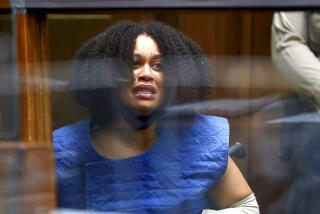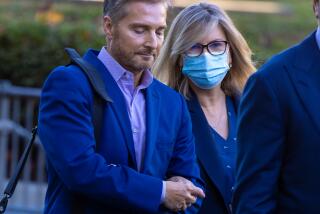Hit-Run Driver Turns Life Into Agony : Woman Seeks ‘Justice’ After Loss of Husband, Despondent Son
- Share via
BOSTON — Carol Nashe paces the floor in the middle of the night, memories flooding her mind.
She remembers that weekend in Maine as she sat on a river bank cheering on her younger son, Harold, in a canoe race: “Go for it, Hal! Go for it!”
She remembers the six-week cross-country trip with sons Rick and Hal and her husband, Russell Weinberg.
She remembers how she and Russell met, at a dance when she was just 16, and married a year later.
Images Darken
Then darker images crowd in. She hears Hal crying over the telephone, telling her Russell is dead, trapped inside a flaming Toyota after another car smashed into his from behind.
Carol Nashe, 47, is a survivor of a victim of a hit-and-run driver, one of thousands of people across the country suffering that private agony.
However, for Nashe, vice president for public affairs for Blue Cross and Blue Shield of Massachusetts and well-known locally for her charity work, the agony is twice as great. Fourteen months after her husband’s death, Hal, then 25 and still deeply depressed over losing his father, was killed in a fall from a utility tower he had climbed.
‘Unknown Vehicle II’
Four years later, she awakens each day believing that there is someone probably still living in Massachusetts whom she considers the murderer of her husband and her son. The police know him only as the driver of “unknown vehicle II.”
Kathi Connelly, a spokeswoman for the state Registry of Motor Vehicles, said that the case is not under investigation and “for all intents and purposes it is closed.”
“Justice has not been served,” Nashe said. “I have a dual reason for wanting to see that justice is done because it’s not one murder that this person has committed but it’s two.”
Her son’s death, she said, was directly related to his father’s.
“He just could not get it out of his mind. He could not. We tried very hard but he could not get it out of his mind.”
According to the National Highway Traffic Safety Administration, fatal hit-and-run accidents averaged almost 1,800 a year from 1980 through 1984. That is slightly less than 5% of all fatal accidents.
60% Never Apprehended
About 60% of the drivers are never apprehended, according to a study the agency did of 1,829 fatal hit-and-run accidents in 1980.
Nashe said that being alone remains difficult, although she has begun dating. She said that charity work eased her pain. She is on the boards of the National Kidney Foundation of America and the March of Dimes and works as a volunteer for the Greater Boston chapter of the Muscular Dystrophy Assn.
Russell Weinberg was 54 on Aug. 7, 1980, when his car was struck from the rear and sent into a guard rail as he was returning to the family’s Sharon home after a Boston Red Sox baseball game.
Nashe refused to read the final accident reports or watch any of the TV news film. To this day, she said, she rarely watches television for fear of seeing a flaming car.
On the Saturday that Hal died, Oct. 17, 1981, she was working at a road race for charity. She was worried about her son.
“He had been out of my sight for one day,” she recalled. “He left on a Thursday night and did not call me Friday or Friday night.
‘Drawn to Home’
“When the road race was over I was just drawn to go home . . . . I was having obviously great concerns because he was having a lot of problems. And he was better when I was there. When I was not around it was more difficult for him. It was a feeling of being left alone that hurt him so very much.”
Shortly after she got home, a police car drove up.
“The police officer told me. I pounded on him, and I kicked him. You’re angry. There’s a tremendous amount of frustration and anger, and you really don’t know who to take that out on. And he was the only person you could do it to. He just stood there and let me pound him. And then I just fell into his arms, and he just hung on to me. I couldn’t stop crying.”
Hal was a cross-country ski instructor at Lake Placid, N.Y., and had been training in white-water kayaking, hoping for a berth on the U.S. Olympic team in 1984.
Talked Down From Tower
The police report said that he had climbed one utility tower in neighboring Easton, Mass., and was talked down but ran into the woods. Five hours later, Hal was atop another 90-foot tower. Officers in an approaching cruiser saw him “push off the cross beam and fall to the ground,” the report said.
Miss Nashe said she believed her son was distraught when he climbed the pole but that in the end he slipped and fell.
She said that there have been times when she felt she didn’t want to be alive.
“That’s when the phone would ring about 2 o’clock or 3 o’clock in the morning and it would be my very good friend, Irma, who would say: ‘I bet you’re up walking around.’ And we would talk. I didn’t sleep. I still don’t sleep very much. If I get four hours’ sleep at one time, I’m extremely lucky.”
As Nashe paces the floor, she said, she asks herself what life is going to be like.
“You try to figure out how you’re going to go on, how you’re going to face life without your friend and your mate and your husband and your lover,” she said.
More to Read
Sign up for Essential California
The most important California stories and recommendations in your inbox every morning.
You may occasionally receive promotional content from the Los Angeles Times.












